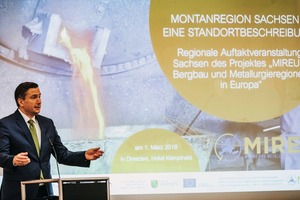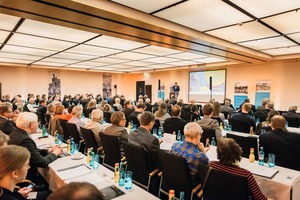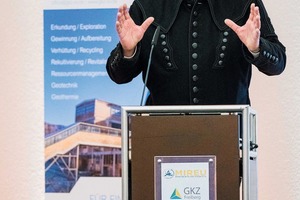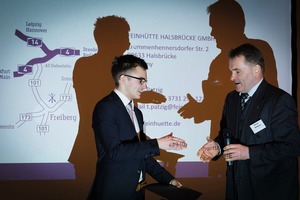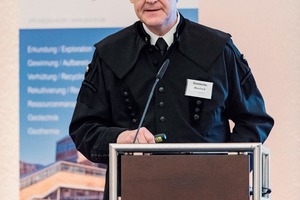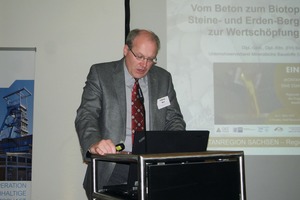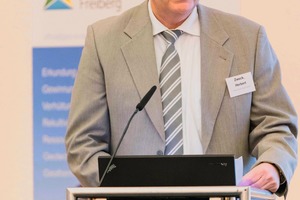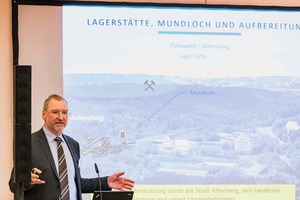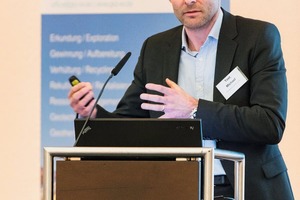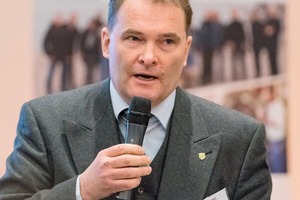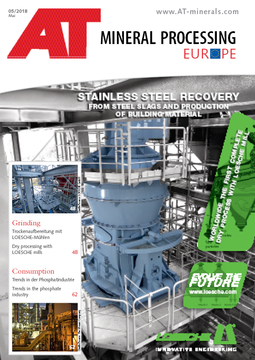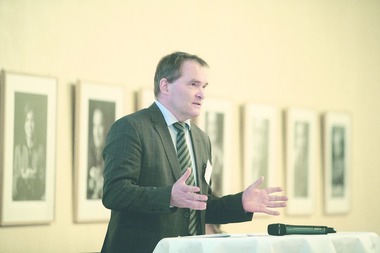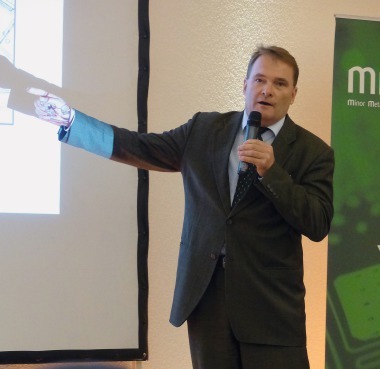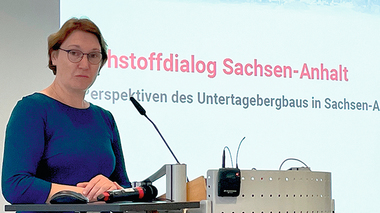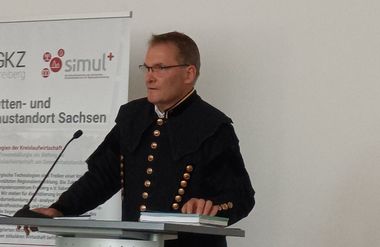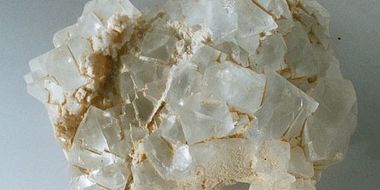MIREU – Network of the Mining and Metallurgy Regions in Europe
MIREU, supported by the European HORIZON 2020 programme, aims to establish a network of all European regions in which mineral resources (extraction and processing) form an integral part of the economy and inject this with life. A total of 19 partner regions that exhibit both commonalities and differences in respect of value creation are to exchange information and ideas, encourage each other, discover synergistic effects, and, based on permanent networking, heighten the profile of the regions and invigorate their cooperation. The MIREU kick-off event was held in January 2018 at the GTK (The Geological Survey of Finland) in Finland with more than 50 attendees from 14 countries.
After the welcome and a short introduction by Chief Mining Officer and member of the board GKZ Prof. Dr Bernhard Cramer, Saxony’s State Mining Authority Freiberg, State Minister Martin Dulig, SMWA Dresden, spoke on Saxony’s status as mining and metallurgy region in Europe. He urged that dimensions of industrial policy in Europe must be strengthened to keep pace with the tremendous developments in the world. Minister Dulig highlighted Saxony’s special standing in the research and development landscape in Germany and even in Europe: 17.3 % of the GDP is spent on science and research. Research into mineral resources is not only based in Freiberg, but at many other universities and research institutes in Saxony. He appealed “The extractive industry must be integrated in all political strategies and awareness of mineral resources must be communicated and promoted on all levels.” Even if the ore mining does not constitute a large branch of industry in Saxony, it is one of the most important, for example fluorspar mining. Stockpile processing was to be supported, but it was necessary to create corresponding compensation areas. The centuries-old wisdom “Everything comes from mining” should read “Everything comes from mineral resources” today. To conclude, he went into Saxony’s position within the network of the European mining landscape and said: “Mineral resources extraction doesn’t work without international networking.” The EU tries to promote these through various projects, such as FAME, REMIX or MIREU, in which the GKZ is also partner. That on its own was not enough: without regional associations, there is no European cooperation.
Details on the MIREU network were provided by Dr Wolfgang Reimer, Managing Director at the GKZ, in his talk “MIREU – The network of mining and metallurgy regions in Europe – Challenges and potential of European cooperation” (see the interview following this article).
Location factors
Three papers were included in this session, illustrating at the same time the many facets of this topic. Tobias Patzig, Feinhütte Halsbrücke GmbH, Halsbrücke began, speaking on “Tin smelting in Saxony – Risks, opportunities and decisions in global competition in the past and in the future”. The company was founded in 1992, now employing 80 people, and is the only lead/tin-smelting company in Germany and one of four remaining in Europe. Even today, around one million euros are invested annually. Production is based on hydro- and pyrometallurgical processes. When precious metals are present, the process is followed by refining based on electrolysis. According to the speaker, the opportunities for the SME were the implemented innovative modernization of the plant, cooperation with Freiberg University of Mining and Technology (TU BAF) and the GKZ Freiberg as well as a good position on the market. He said the risks were global as well as of a political nature, specifically the shortage of skills, increasing bureaucracy, negative political and media campaigns as well as excessively high electricity prices compared to in other EU countries. “The recycling of many secondary raw materials or waste is worthwhile again due to constantly rising tin prices, but that alone will not be enough, primary ores are needed and – in Saxony they are practically sitting on the doorstep!” concluded the speaker with reference to the considerable tin deposit in the Ore Mountains.
The subject of acceptance already broached by State Minister Dulig was also addressed by Dr.-Ing. habil. Manfred Goedecke, IHK Chemnitz, in his remarks on “Saxony’s activities to improve the location factor of mining and industry acceptance”. Starting from the challenges for international mining such as population growth, rising living standards, new products and technologies, covering the demand for primary resources only with deposits at greater depths or even in asteroid fields, poorer ores as well as the ever stricter environmental regulations, he expressed a homage to mining in the sense of it being an absolute necessity: “Many today see mining only as a dinosaur – that is as no longer in existence – and the public image in Germany is marked by rejection and mistrust. The bank crisis cost us billions, the antipathy to industry will cost us our future.” Insofar, political action must be called for stop this path. Saxony has responded with its Resources Strategy 2012, in which the guiding principles of Germany’s resources policy are laid down, but in Saxony, too, mining and the extractive industry have negative connotations in public perception. Dr Goedecke proposed a series of measures for improving the awareness of mineral resources both on the corporate side (improving transparency, public relations, professional conflict management, networking on acceptance issues) and with the media (press tours; greater use of social media). The speaker sees a need to catch up in science and education, for example the inclusion of appropriate topics in curricula and text books. And finally, he referred to future tasks, namely the more systematic implementation of Saxony’s Resources Strategy in all of Saxony’s state ministries and offices, as well as the establishment of a competence centre for mining and extractive industry acceptance at TU BAF.
The same acceptance problems confront the aggregates industry, which, however, has made efforts for decades to improve its image with countermeasures and sustainable practices, as Bert Vulpius, UMVB e. V., Leipzig impressively communicated. His paper under the heading “From concrete to biotope – contributions of the aggregates industry to value creation in Saxony“ shed light not only on the innovations in concrete such as optimization of the grain sizes, new additives, new technologies, development of new concretes, e.g. carbon concrete, but also showed that extraction to meet demand and with on average 39 km transport distances are positive features of this branch of industry. Especially in Saxony a good local distribution of the extraction areas can be found. Impressive were the remarks of the speaker on the claim that the extraction sites and the aggregates industry are hotspots for biodiversity. Referencing a number of examples, he explained how new habitats are created as a result of the extraction of resources, e.g. for the sand martin (in Germany, most of these birds can be found in abandoned surface mines), the little ringed plover, the eagle owl or the natterjack toad. Accordingly, contributions are made to conserving species threatened by extinction and species protection in general, which is actively supported by the companies with targeted landscape protection measures in the affected extraction areas.
Importance of indigenous industrial minerals
In this session, successful companies in Saxony were presented that are involved in the extraction, processing and the sale of indigenous industrial minerals.
First, Herbert Zweck, Fluorchemie Stulln GmbH, spoke on the importance of fluorspar for the chemicals industry and the standing of German deposits in global competition. The Fluorchemie Group includes the sister plant Fluorchemie Dohna GmbH (producer of hydrofluoric acid). Fluorine supply in Europe must be regarded as critical, i.e. fluorspar is a strategic and critical resource, 85 % of the European demand currently has to be imported – from China, Mexico, South-Africa and Morocco. Moreover, the recycling quota is below 1 %. The speaker pointed out ways to alleviate this predicament, which in 2018/19 will be exacerbated by further price increases and the closing of a number of mines in Namibia and Kenya. In Saxony for example these include the exploration and extraction of indigenous deposits (Niederschlag: approx. 3.1 mill. t raw spar with 1.3 mill. t fluorspar, extracted by the Erzgebirgische Fluss- und Schwerspatwerke GmbH; Pöhla-Globenstein: including around 720 000 t fluorspar, Schönbrunn/Bösenbrunn deposit: 2.12 mill. t raw spar with around 900 000 t fluorspar) but also political support for these workable projects.
No less interesting was the talk by Prof. Dr Armin Müller, Deutsche Lithium GmbH, Freiberg, which focussed on a possible utilization of the indigenous lithium present in the zinnwaldite from the Zinnwald deposit. Here, Prof. Müller sees an important basis for the Li-processing future industry in Saxony with a view to electromobility. He described the progress of work at the current point of time (obtaining an extraction licence for Zinnwald, exploration licence for Falkenberg, near Altenberg, conclusion of the exploration drillings 12/2017, analysis of a large sample of 100 t). The deposit includes around 26 mill. t ore, which corresponds to around 550 000 t lithium carbonate, planned is the extraction of 500 000 t/a ore. Prof. Müller provided further details on extraction and beneficiation of the ore as well as utilization of the tailings and recovery of the valuable Li materials. For the latter, a chemicals factory is to be erected at BASF in Schwarzheide. Planned are investments of € 100 mill. to € 120 mill., the working life of the deposit is estimated at 25 years. This year, the mining operation is under planning by GEOS Freiberg, driving of the slope and the mine is scheduled for 2019/2020.
With the extraction of marble being discontinued at the Lengefeld (2014) and Hermsdorf (2016) mines, GEOMIN Erzgebirgische Kalkwerke GmbH was faced with the challenge of developing new limestone deposits. Managing Director Achim Stöck reported on the successful path to this in his paper headed “Developing new high-grade marble deposits for the construction industry based on the example of the Hammerunterwiesenthal deposit”. The plan approval procedure had been successfully concluded a few days previously. Besides calcite-dolomite marble (> 70 % calcite, > 20 % magnesite), pure calcite and pure magnesite marble are extracted. Consequently, the product range of the two developed mines can be maintained. With 45 employees, the company is currently operating an active underground mine, a surface mine in exploration, and the two processing plants in Hermsdorf and Lengefeld. The reserves of the deposit will last for around 50 years, currently 150 000 t/a are extracted, although doubling of this tonnage is planned. The GKZ plans to visit its member GEOMIN in August 2018 for this purpose.
European cooperation
In this session, three speakers reported on the experiences that they have already gathered with regard to European cooperation.
For instance, Michael Tost, Montanuniversität Leoben, presented Austria with a focus on Styria as the MIREU partner region existing and future cooperations with Saxony in mining and metallurgy. There already exists a series of cooperation schemes, for example in Germany with TU BAF such as the international mining study course AMRD (Advanced Mineral Resources Development) or the study programme (ADMIRED LAB – Advanced Mineral Resources Development Labelled) with TU BAF and the University of Dublin. Other cooperation initiatives are under consideration, even if mining in Austria no longer plays the same significant economic role as it used to (responsibility being moved from the Ministry of Economic Affairs to the Ministry of Sustainability and Tourism).
Dr Andreas Barth, BEAK Consultants GmbH, Freiberg (BEAK) explained how important it is to make sufficient data available to interest investors in locating to an area. With reference to many national and international projects, such as in Tanzania, Namibia, Uganda, Ghana or Kosovo, he presented how BEAK goes about meeting the expectations of investors and making information available on the exploration and prices of mineral resources, the geological but also the political and economic conditions as well as the infrastructure. A key instrument for this are mineral prediction maps. For Saxony, these can be retrieved from the BEAK database so that everyone can obtain this information. The availability of data is extremely important and it should be freely accessible and not – as in the case of Wismut AG – unattainable. To conclude, Dr Barth stated that Germany was well on its way to attracting investors. It was, however, also important to protect resources that have not been exploited as yet and not to build on top of these as then deposits would then no longer be accessible.
At the end of the event, in his closing remarks, Dr Reimer, GKZ Freiberg Regd., gave a positive assessment of the meeting. With the positive response to this first regional event, a continuation in around two years certainly seems a sensible idea. Dr Reimer pointed out two talks that are being held within the scope of the MIREU project this year: 1. “Cornwall – a European mining region – yesterday, today, tomorrow” (a talk by Benedikt Steiner M.Sc., Cornwall, on 21.06.2018) and 2. “Mining and Innovation” (talk by Dr Marco Roscher, Freiberg on 20.09.2018) at the Freiberg Colloquia respectively.
AT: Which partners are working together on the project and what task have they taken on?
Dr Reimer: We have 29 partners from 19 mining regions across Europe. They include representatives of relevant authorities, regional developers, representatives from the industry and research with high degree of networking as well as institutions from Brussels for coordination of regional value creation.
AT: How do you see the future opportunities for mining in Saxony?
Dr Reimer: With MIREU, we contribute to mining in Saxony and its strong metallurgy sector by enabling it to experience key impetus derived from cooperation with European partners and also to give important impulses. This includes issues such as awareness of mineral resources, mining acceptance, funding policy, so-called “intelligent specialization” and cooperation on national and international levels of applied research. The optimization of these individual aspects can help mine operators and developers to realize their projects even more efficiently and smoothly, but they can also address the network with problems. To this end, “stakeholder meetings” are held intermittently.
It is already apparent that state involvement in mining differs across Europe. It ranges from governments turning away from mining to active support, also in the context of specific funding. From this, Saxony can learn to realign itself this, also with the continuation of its Mineral Resources Strategy as well as the development of programmes for regional development. Especially the latter show a great need to catch up and stronger prioritization in the support of active mining.
AT: What possibilities do you see for making the image of the extractive industry in Germany more positive in people’s minds?
Dr Reimer: The paper by Dr Goedecke cited initiatives of the GKZ and the Chemnitz Chamber of Industry and Commerce. These range from a better coordination of the implementation of Saxony’s Mineral Resources Strategy between all ministries to improve the framework conditions for political action to concrete steps, like the revision of the chapter on mining in the school books. Here, opinions are conveyed rather than facts from which to form an opinion, as should be the case. Cooperation with schools has also shown the open-mindedness especially of the teachers to a new perspective on mining. In the economically important sector of the extraction of mineral aggregates, the approach of the trade association for mineral construction materials in Leipzig shows that the communication of the biodiversity of a mining site or abandoned areas leads to more openness towards mining. To this end, mine and quarry operators need to address this topic. The case studies show that mining areas have a much greater biodiversity compared with the monotony of excessive, large-scale agriculture. And that without even having to mention glyphosate to understand where the actual problems lie in the decline of biodiversity – and that over much larger areas. The GKZ shares the view that the efforts of many like-minded, in which we only play a part, are gradually taking effect.
AT: How do you assess the success of the event?
Dr Reimer: With over 130 attendees from almost all interest groups, the event was a successful start to disseminate information on the project “among the people”.
The speakers and attendees expressed important messages, and we must make sure these reach the right addresses, especially the policy decision-makers in the parties.
In public discussion, mining tends to be dominated by ideological interpretations. The open-mindedness of Saxony’s Minister for Economic Affairs showed in this respect an encouraging policy standpoint in Saxony. In Germany, Saxony remains an ambassador for strong mining and in Europe a strong partner to convey the messages of mining!
AT: Thank you for these interesting insights!
CAS (Coordination/Support) Project within the framework of the HORIZON 2020 working programme 2016-2017
Division: Social Challenges Climate, Environment, Resource Efficiency, Resources
Duration of the project: 1.12.2017-30.11.2020
MIREU aims to establish a network of European regions in which mineral resources (extraction and processing) also comprise an integral part of the economy. The total of 29 partner regions exhibit commonalities, but also differences in their value creation in the context of socio-economic and ecological challenges and opportunities. The project is not only seeking synergistic effects, but also content for a long-term network to invigorate cooperation and heighten the profile of the sector on various levels in civil society and on the professional marketplace.
The project mission is the development of coordination and support mechanisms among the participating and other European regions to culminate in the establishment of a sustainable network, administered by a central committee headquartered in Brussels. In the investigation of the regions, the key is a comparison and analysis of regional-specific factors in context for the extractive industry, research and management of mineral resources and private investment. To this end, the corresponding framework conditions are studied and SWOT analyses compiled, e.g. from a comparison of the RIS3 architecture, of the regions including their industrial and social indicators and also of non-professional, such as civil engagement.
The MIREU network is to contribute to exchanging and improving experience and knowledge along the value creation chain for mineral resources. The different regional-specific geographic, cultural, social and historically rooted as well as economic differences are to be taken into consideration – also with regard to their different degrees of organization.
The main tasks of the GKZ are in the build-up of the network - and here in greater depth based on example – of selected mining and metallurgy locations (regions). To this end, structures are to be developed to address and coordinate “stakeholders”, their identification, participation in the SWOT analyses, especially on mining heritage, research capacities, SLO and smart specialisation and benchmarking for suitability of regions for selection processes. For this purpose, we are arranging workshops at different EU partners. Further, we are involved in the exchange of experience and improvements to increase the awareness of mineral resources and the acceptance of mining and metallurgy.
Contact:
Geokompetenzzentrum Freiberg e.V.
GF Dr. Wolfgang Reimer

